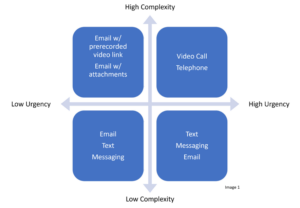An excerpt from the collegiate textbook, Leadership Strategies for the Hybrid Workforce: Best Practices for Fostering Employee Safety and Significance; Ohlson and Goel, 2022
In today’s business environment, professionals are often pulled in multiple directions and can easily be distracted from their primary objectives. From high volumes of emails, Teams™ messaging and social media swiping, to business travel, meetings, and office politics, there are countless ways to get pulled away from the core focus of any job role. Add in a typical work from home environment and the list of distractions grows exponentially. In most cases, the onus falls on leadership to create an environment of accountability and high performance for the organization. To hold a business team accountable, leaders must gain a deep understanding of each team member’s “why,” utilize pertinent metrics to measure progress, and maintain clear and consistent lines of communication with each individual and the team.
Understanding what drives each team member to show up each day is a critical element in holding a team accountable for performance
With the pressures of day-to-day business, it is easy for leaders to only focus on productivity and the bottom line while forgetting that the team members responsible for achieving the desired results are themselves humans with their own thoughts and needs.
While focusing on the bottom-line, many new leaders often learn the hard way that neglecting the human element of their team hinders long-term success. Although seemingly counter-intuitive, the more personal and consistent the care leaders apply to their team, the better the overall team performance will be. (Jones, 2017). In his book Start with Why: How Great Leaders Inspire Everyone to Take Action, Simon Sinek discusses the importance of understanding each team member’s “why.” Sinek explains that the goal is to understand what drives and motivates each individual team member to empower him or herself to perform at his or her best. (Sinek, 2009)
To accomplish this goal, corporate coaches at Benchmark Training utilize an effective tool called The F-Bomb, which is designed to help leaders get to know what drives individuals on their team. While the name may initially catch leaders off guard, participating in the F-Bomb assessment uncovers a trove of information that can be utilized to foster a supportive work environment and a cohesive, driven team. Three simple words, not four letters, come together to create the synergy needed for individuals to charge through self-imposed limits, which may hold them back from achievement.
Working one-on-one with individual team members to help them Focus on their Futures, Face their Fears, and Fuel their Fires is the beginning of a team’s success journey.
When implementing the F-Bomb, leaders should follow the following steps during a one-on-one meeting with each of their direct reports:
Future:
The first step is to help direct reports clearly define their future. Having clear long-term and short-term goals is certainly a best practice when it comes to being successful in just about anything. Leaders should encourage their employees to focus on their long-term goals, both professional and personal, within the next one-to-two-year span. Leaders should begin by asking their employees to write down the vision that they would like to see unfold within the next one to two years. The intention is to mentally position this vision front and center. It is essential to keep self-limiting beliefs, or self-proposed fears, out of this part of the exercise. For now, the focus is simply on the desired future. Once employees have a clear picture of where they want to be in the designated time frame, leaders should ask them to note one or two steps they can take each day to Focus on their Future. Together, leaders and direct reports can now use this information as an action plan to help employees take steps towards achieving their goals.
Fears:
Next, leaders should guide their employees through the process of identifying what might scare them into inaction. Fear of failure? Fear of embarrassment? This step is often where things get a little tough; most people don’t like to admit what their fears are, and that’s a big problem. Allowing employees to ignore their fears may result in stress and anxiety, lack of initiative, feelings of inadequacy, or distraction from work responsibilities, all of which often culminate into an overall lack of achievement potential in the workplace. By guiding employees to acknowledge fears, leaders can help bring actions more freely to fruition. Defining fears creates tangible opportunities for improvement, which promote taking steps towards conquering fears. Once employees are focused on fears, leaders should ask employees to list one or two actions they can take to face those fears. For example, if an employee fears public speaking, the employee might consider joining an organization such as Toastmasters®, which can be a productive first step in facing that fear.
To use a quote from the movie, The Usual Suspects, “The greatest trick the devil ever pulled was convincing the world he didn’t exist.” Leaders should not let their employees’ fears be the devil that holds employees back from being the best they can be.
Fire:
The final step in igniting employees through the F-Bomb is to help them define what charges them up. After creating a future-statement and identifying those lurking fears that could hinder achieving that desired future, leaders will complete this one-on-one meeting by helping employees uncover their driving force and asking them what fuels them. This step is all about understanding each employee’s “why” so that leaders can help the employee fuel that fire along the way. As the culminating step, understanding this “why” is an essential part of the success formula but is also, unfortunately, where many leaders drop the ball. Not only can it be difficult to define an individual’s fire but ot is also easy to neglect it and allow that fire to smolder. Leaders should ask employees what they can do each day to Fuel their Fire to assure that this fire burns strong through the toughest storm, both in and out of the workplace. Helping them tend this fire is easy to do if follow-up conversations are integrated into monthly or quarterly one-on-ones.
In sports, the objective is to score more points than the opponent. The goal is clear, and the team’s leadership is focused on building a strategy that will outperform competitors by recruiting and developing the best players. Ultimately, however, it’s up to the players to perform on the field to execute the strategy.
In business, winning can mean something different for each company; therefore, leadership must first design what winning means to the company. When the stakeholders of the business agree on their definition of winning, only then can leaders begin to develop the strategy they feel is best to achieve that win. With the main target or targets defined, departmental leaders are responsible for leading their team through the day-to-day challenges of achieving their specific objectives.
To orchestrate all these moving parts, it’s key for leaders to set clear targets for the year and work together with their team members to break down those annual targets into quarterly and monthly objectives. By breaking annual corporate objectives into smaller objectives, it can be easier for the team to stay on track. These targets are considered lagging indicators of performance, meaning they show the results after they have occurred. For example, if a sales department’s goal is to bring on 10 new clients each month, leadership would clearly need to track the number of new clients brought on throughout the month. As members of the team track this number, they are noting the current status of their goal and cannot predict future outcomes with just that number. Therefore, while lagging indicators are useful to show current or historical status to the goal, they do not help leadership influence activities that will help deliver the results.
Metrics that help leadership measure activities that are likely to deliver the results needed by the company are called “leading indicators.” Once the monthly objectives are clearly defined, leadership must then work together with team members to define the activities necessary to achieve the defined monthly objectives and measure these leading indicators on a real-time basis.
To help explain why real-time measurement is important, let’s look at a hypothetical scenario in which you and coworkers play softball in a corporate league, and you’ve made it to the finals, which means you must play the rival team that happens to be a competitor in your industry. Just as the game starts, the scoreboard breaks and there’s no way for any of the players or coaches to know what the official score is, what the current inning is, or what ball the player is on. You’ve got coaches doing their best to track the data, players trying to scream information across the field, and everyone arguing about the status of the game. Finally, both teams become disengaged from the game, and everyone walks off the field disheartened and frustrated.
While this example in sports is unlikely to occur, a very similar parallel occurs month after month in business when leaders fail to provide a clear scoreboard for their team. Professionals in business need the same visibility of their progress as professional athletes need. That’s why it’s important for leadership to define and track Key Performance Indicators (KPIs) for all levels of the company, starting with the company as a whole and then moving to each department and ultimately to everyone.
Effective intradepartmental and interdepartmental communication can create a competitive edge within any company. Leaders can better understand the value of effective communication for a team by considering the effects of poor communication in an organization.
For example, consider two companies with the same technical capabilities, market presence, and financial resources competing in the same market. Company Type A created a culture that promotes effective communication across departments, and company Type B has not.
Table 1 anecdotally shows the likely outcomes of different common business scenarios based on how each company does or does not effectively nurture and promote effective communication within the company as a whole and within each department.
Key Ingredients:
In order to build and nurture a culture of effective communication, regular communication must be structured both one-on-one and in strategic teams, take place on multiple mediums with consistent and appropriate frequency, and be held both formally and informally.
Communication Structure
Leaders should utilize both one-on-one meetings and team meetings as tools to build open lines of communication because each of the two structures will provide a different benefit. Team meetings provide an opportunity for the team to discuss complex challenges and solutions that affect multiple people and/or departments, to share the accomplishments they are responsible for, and to gain an understanding of the full team’s and company’s status. One-on-one meetings are better utilized by leadership to provide individual feedback and coaching to team members and to enable individual team members to communicate field and other pertinent information upward to leadership. With an understanding of the purpose and use of each meeting type, leaders are better equipped to create a stronger culture of communication when both types are used appropriately.
Communication Mediums and Frequency
For decades, leaders have navigated various complexities of team environments. From the less complex situations of having all team members in one room at the same time, to the extreme complex situations of working with teams spread throughout the globe covering various time zones. As communication technology improves, leaders have access to better options, and communicating with team members around the world becomes much more instant and life-like. Consider, for a moment, kings and military generals communicating with their lieutenants via a messenger traversing hundreds of miles on a horse as compared to sending a Teams™ message or jumping on a virtual video call such as Zoom™ or WebX™.
With these additional tools to which leaders now have access comes the challenge of knowing what tools are best used for each type of communication. For example, while texts are fast, they lack tone and body language to help provide the context of a message. And while in-person meetings are best for tone and context, in many cases they are too expensive and/or require too much time for travel.
To help better understand which communication tools are best used for specific needs, leaders should consider two factors: complexity and urgency. In simple terms, when a topic is more complex, the most in-person-like communication is the best option. When a topic is more urgent, the fastest method of communicating is best (see image 1).

Communication Cadence
In addition to utilizing the appropriate communication medium for the desired outcome, leaders should also create a consistent cadence for one-on-one and team communication. Best practice for setting up the appropriate cadence is based on many factors including the complexity of the efforts required from the team and individuals, the experience level of the team and individuals, and the stability of the environment during the specific period.
In situations where complexity is high and/or the environment changes quickly, a higher frequency of team and individual meetings is more appropriate. The same is true when the team and individuals are less experienced in their roles. Additionally, proximity of team members will also be a factor in necessary frequency of communication.
As events unfolded during the COVID-19 pandemic, the corporate coaches at Benchmark Training helped leaders in various types of organizations navigate the needs for the appropriate communication with teams that changed their work environment from working together in an office to working remotely with as little as 24 hours’ notice. The coaches found that team members felt less anxious and were more productive when they communicated as a team with a frequency ranging between daily and three times per week as compared to just one time per week. As these same teams became more accustomed to the new work environment, meeting frequency was reduced to one to three times per week and achieved the same positive results.
Formal Vs. Informal Communication
The final key ingredient to effective communication is combining the appropriate level of formal and informal communication.
Formal communication can be defined as communication that takes place with ample notice, has a structured agenda, and has a defined facilitator or facilitators. Formal communication can take place as team meetings as well as one-on-one meetings. To assure the best outcome for formal meetings, leaders should provide at least 48 hours’ notice for the meeting, send the agenda out to the participant or participants at least 24 hours prior to the meeting start time, and set clear expectations for how participants can best prepare for the meeting to assure they are engaged in the content and the outcomes of the meeting. While formal meetings are effective and valuable, it’s important to note that they can be overused.
In many organizations, formal meetings have been over utilized to the point at which participants at all levels of seniority of the organization find them spending over 50% of their work hours attending meetings, leaving minimal time to get the necessary work completed within their regular work hours. To avoid overusing meetings, leaders should consider the total cost of the meeting including calculating the hourly rate of each attendee. Including this expense helps weigh the value of each meeting and assures that only those who are actively contributing to the meeting are invited.
Informal communication can be categorized as communication that does not include the criteria noted for formal communication. In most cases, informal communication is impromptu and can take place between all levels within the organization. From watercooler talk to Teams™ messaging, to a phone call and any communication in between, informal communication takes place very regularly and has a big impact on how thoughts and ideas are shared throughout the organization.
Leaders can maintain open lines of communications by utilizing informal communication with their direct reports to help their team navigate unfamiliar and/or unstable environments and also gain up to date field intelligence that can be utilized in high level decisions.
Conclusion
With the demands of today’s complex and highspeed business environments, there’s more to leading a team than just measuring progress and providing motivation.
As leaders navigate new and complex work environments, creating a culture of effective communication and accountability will play a key role in the performance of their team.
By taking intentional action to better understand the human side of each team member, tracking pertinent metrics to measure progress, and by maintaining clear and consistent lines of communication with their teams, leaders can increase their chances of success in today’s business environment.





